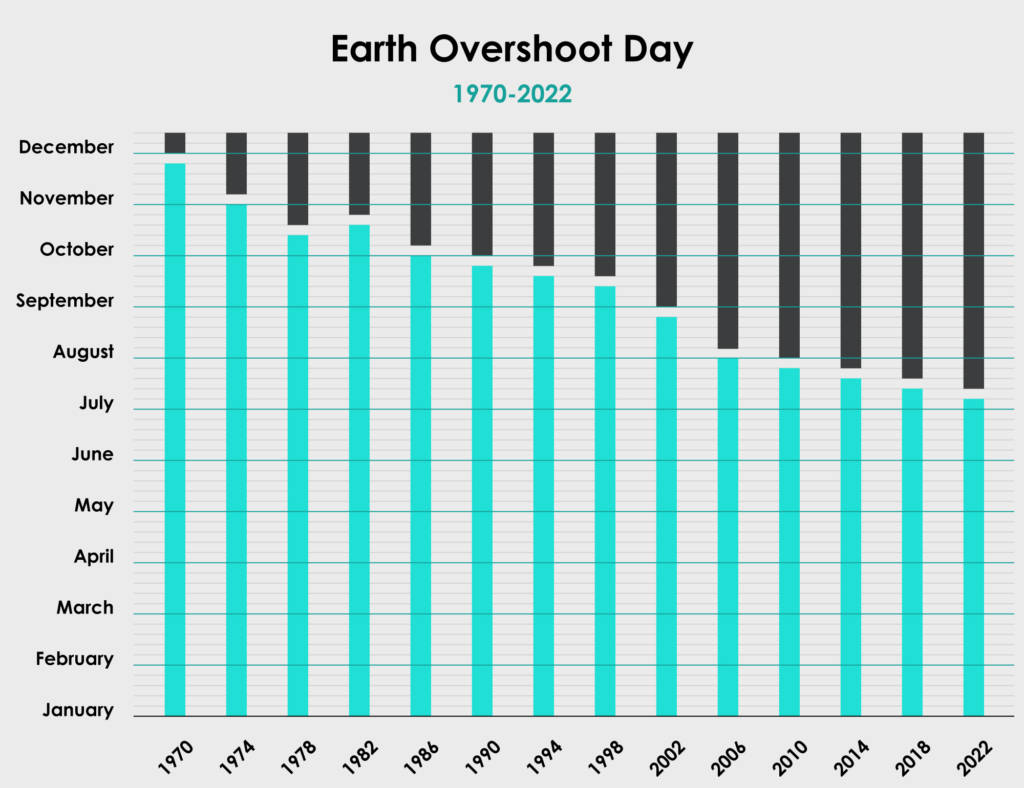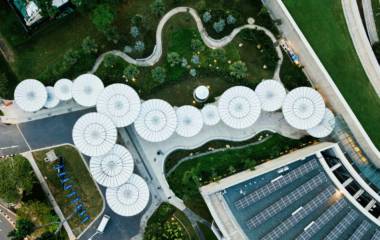A Stephanie Glover and Clémentine Tanguy collaboration.
Today is Earth Overshoot Day, and it marks the date when our demand for ecological resources exceeds what the Earth can regenerate in a year. We have used up the Earth’s budget, and for the next 156 days, our economies will run on an ecological deficit. Earth Overshoot Day is calculated by Global Footprint Network, an international research organization providing tools and resources that help position ecological limits at the center of economic decision-making.
Over the last few decades, Earth Overshoot Day has been inching up the calendar, from the 25th of December in 1971 to the 14th of October in 1990, and finally hitting July for the first time in 2018.

This year, as the UK experienced its highest temperature on record (more than 40°C), fires and extreme conditions are sweeping France, Spain, Greece, and Portugal, and India and Pakistan were hit by devastating heat waves reaching almost 50°C, the realities of climate change are sobering.
In this article, we will look at why drastic action is needed to reduce ecological overshoots, what this means for the built environment, and solutions that could help move the date.
According to our calculations…
Earth Overshoot Day is calculated by measuring the supply of resources and services from our ecosystems against populations’ demands in the same manner that bank statements measure income against expenditure.
On one side, we have to consider a country’s supply, or biological capacity, which is represented by its productive land and sea areas, including croplands, fishing grounds, forests, and built environments. On the other, a country’s ecological footprint measures the population’s demand for food, fish and livestock, forest and fiber products, land for urban infrastructure, and green spaces to absorb emissions from fossil fuels.
Supply and demand are both measured in global hectares with average productivity. If the demand of a population for ecological assets exceeds the supply, that country will run an ecological deficit, in which case demand will be met by importing, liquidating its natural resources, and/or emitting carbon dioxide into the atmosphere.
In 2020, due to the COVID-19 pandemic, the date of Earth Overshoot Day was moved three weeks later than the previous year (29 of July 2019). Due to the national lockdowns and the exceptional slowdown of the current economic model, human activity slowed down and the C02 emissions were reduced. However, this downward trend was only temporary. The economy picked up as before and Earth Overshoot Day continues to advance a little further each year.
Moving the date of Earth Overshoot Day back 6 days each year would allow humanity to reach one-planet compatibility before 2050.
Uniting efforts to change the date
Our human capabilities are not limited to the finite resources on which we still depend. Our transition to a fair and sustainable world will only be made possible with assimilation, innovation, and effective planning. Not only is the green transition technologically viable, but it also offers tremendous economic benefits and our best hope for a fair and sustainable future.
Currently, economic planning and climate action are still viewed in silos. By embedding sustainable thinking into economic decision-making, countries and governments can transform their resource consumption while drastically improving peoples’ quality of life.
If public investment and economic planning are executed to rapidly transform our resource dependence and trajectory, we can accelerate the green transition, mitigate climate risk, and avoid poor investments that could result in stranded assets.
Also read: The growing risk of stranded assets
Cities are responsible for the majority of the world’s economic activity, energy consumption, and greenhouse gas (GHG) emissions. To significantly cut emissions, the built environment will need to both use less energy and take greater advantage of periods when intermittent renewable energy is available.
Changes in cities (design and management) are therefore one out of the five key areas for solutions identified by Global Footprint Network. Other solutions include energy; food (production, distribution, and consumption); planet (conserving and regenerating nature); and population.
Country by country, consumptions differ. If the world all lived as Qatar is doing, we would reach the point of deficit in early February. The UK, using 2.7 Earths, is in a similar position as most of Europe. Meanwhile, if we all lived as in India, we would only be using 0.7 of Earth’s resources.
Real estate solutions: 4 dimensions to consider
To achieve sustainability through bold actions, we identified 4 key solution pillars to be implemented at a global level in the real estate industry.
1. Smart Cities
Today 55% of the world’s population lives in urban areas, and this figure is expected to grow to 68% by 2050. How the built environment and cities are planned and developed is therefore instrumental to balancing the supply of natural capital and the population’s demand. Smart city planning strategies are a must to make sure there is enough biological regeneration to avoid excessive human demand that would overconsume it. Given the rapid urbanization around the world, these strategies are essential to help move the Earth Overshoot Day date. If applied worldwide, this could move it by 29 days.
Smart cities use data and digital technologies to achieve a greater quality of life for today’s communities and for generations to come while reducing the risks posed by climate change. They also manage their resource metabolism carefully to cut dependence on energy-intensive processes and products and aim to use carbon-free energy systems, resource-efficient processes, and more effectively integrated transport systems. Overall, they use more advanced energy management (particularly in buildings), and implement foresight through better sensors and communication systems that allow them to react more swiftly to new circumstances. Smart cities are increasingly efficient and able to operate on a smaller resource budget.
Many cities are not yet on track and all urban areas need to adjust to the reality of increased climate extremes (extremely high temperatures, intense precipitation, etc.) and reduced resource access. The potential to expand smart city concepts is still untapped, therefore, the increased use of renewable energy and the rise in energy efficiency can contribute significantly to the climate goals.
2. Retrofitting
The built environment accounts for approximately one-third of global energy use, and one-fifth of CO2 emissions. Retrofitting existing apartment buildings can reduce the energy needed for heating and cooling by 80-90%. By itself, implementing retrofits for multi-family housing worldwide would move Earth Overshoot Day by 5 days. As numerous households can share the benefits of upgrades to apartment buildings, it’s important to know that these have a much higher potential for energy savings than single-family homes. Improving the energy efficiency of these buildings can be done by updating their insulation, heating, ventilation, air conditioning, and lighting systems. For example, shared walls between units mean that less insulation is needed for each household and the cost can be split among many households.
Over 36% of global households currently live in apartment buildings. This share will increase further given current trends in urbanization. As most buildings are expected to stay standing many decades into the future, their present and future renovation will have a major influence. So ensuring that these existing structures are as efficient as possible will directly affect long-term energy consumption patterns.
A lack of data on existing energy consumption in ancient buildings is often listed as an obstacle to efficiency upgrades. Deepki’s data intelligence platform allows users to collect data, project and visualize pathways and thereby allocate their resources to the most efficient course of action.
Read more: Retrofitting: 5 reasons why you shouldn’t overlook it
3. Green certifications and labels
While some cities like Amsterdam (named ‘Mandela neighborhood’, an entire neighborhood built from wood is due to start in 2025 in the city’s south) are putting out quite bold commitments, governments cannot meet these undertakings without a very proactive program to decarbonize the built environment.
In parallel with the European and national mandatory regulations, real estate actors can adhere to a number of practices and policies that have been proven to be effective in reducing their environmental impact. Some of these include using renewable energy sources, increasing energy efficiency, and reducing waste.
In addition to benefiting your company’s bottom line and protecting building occupants, greener certifications and labels help to lower carbon emissions, thereby, to reduce real estate actors’ carbon footprint and support projects that have a positive impact on the atmosphere, the community, and the environmental health. There are different levels of being green or ESG certified and asset managers and funds can choose which one is right for their portfolio.
You can learn more about which certifications and labels to choose for your portfolio and assets by getting in touch with Deepki’s experts.
Read more: A comparison of regulations, certifications, labels, and ESG scoring in Europe
4. Digital twins and data
Measuring and reporting carbon emissions is the first step toward concrete action, but it remains a challenge for both investors, asset managers, and occupiers. While there are established standards for carbon measurement, there is a lack of harmonization in terms of data structuring and reporting.
As the access to data is essential to the delivery of a net-zero built environment, Deepki can collect and structure your data to make sense of it. Deepki’s platform, Deepki Ready, monitors CO2 emissions reduction targets and portfolio consumption based on historical data.
Digital twins can also be a key solution and help professionals to deliver significant carbon savings during the asset’s operational phase. A digital twin is described as a virtual representation of real-world entities. By integrating BIM (Building Information Models), digital twins can also store data on building products and materials. They can use real-time and historical data to represent the past and present and simulate predicted futures’ of a building/portfolio. They can also support optimal decision-making and effective action. In doing so, they can help drive the transition to a circular economy by allowing for the reuse and recycling of materials as building life cycles drawdown.
The cost and time-consuming of these key solutions pillars are perhaps the main challenges and require expertise. In the long run, these are efficient solutions but they’re among many possibilities that can contribute to bringing humanity out of overshoot.



